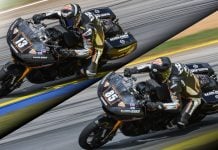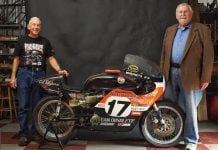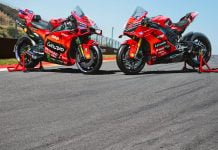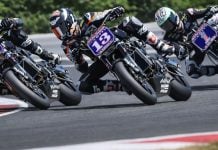FIRST PERSON/OPINION By Phil Rispoli I am the founder of Coolskunk KyDs Racing, a youth-based racing team that initially was established to work with and sponsor young riders in dirt track, and I have some input on 450cc motocross powerplants and racing. We have been using 450cc single-cylinder powerplants for racing since 2002. We primarily race a 450 in dirt track however in 2007 we started racing it on road racing tracks with the thought that the dirt bike set-up with 17-inch wheels would make a good trainer for our young riders coming through the ranks. Regarding the 450cc power plant; it is our experience in dirt track that these motors require incredible amounts of maintenance in order to stay in top form to race at the national level, whether that be amateur national level or GNC national level. A top national rider, whether that is an amateur national or GNC national competitor, hammer the crap out of an engine in competition. In dirt track the majority of the Pro class circuit which is made up of young riders 16 years old and older, run all venues that their Expert counterparts run except it is all done on a 450cc motocross OEM piece of equipment. This includes half-miles, miles, short tracks and TTs. The most grueling on the motor are the mile and half-mile events which for the new Pro class is the majority of the classes. In these events the top riders are wide open with almost no letting up of the throttle at all for the entire day’s event. That will include an open free practice, two timed qualifying practices, one heat, possibly a semi and then a main event. That’s roughly 24 laps of racing these powerplants at almost wide open throttle positions for the top riders. In the early days, dirt trackers were blowing up a lot of motors. People didn’t understand the 450cc motocross powerplant that well, much porting was being done, mods to carburetors and aftermarket ignitions were used. The stock bikes with about 40 horsepower were being pushed to 60 horsepower at the national levels. Stock rods were breaking, pistons were being caught in cylinders, valves were being dropped, cam lobes broken and there was just a lot of failures. Over the years, things got better and manufacturers starting incorporating the porting that the specialists were doing into their OE designs and the newer bikes started coming out with more power in stock mode. (The 2009 Honda can make 60 horsepower with very little porting, a bunch of electronic tuning with the new ignition, and new pipe on VP C12 fuel.) We were still seeing failures out there and it was a known fact that the stock rod was a weak link. Aftermarket companies like Falicon and Hot Rod introduced products and the top teams migrated to these aftermarket parts in order to increase reliability, mostly Falicon for the top teams. We use Hot Rods for our short track and TT motors, but Falicon for anything else. The top teams continue to do this today, and even weight the cranks in order to get some better traction from the thumpers on the dirt. On our team we have a rigorous maintenance schedule, not unlike the top national teams. Our 450cc motors are checked after each race. If we race short track, we do a leak down, adjust valves, change oil and get ready for the next race. If we race a TT, we do the same. If we run a half-mile all the basics are checked and we would only run two half-miles without taking off the cylinder to check piston wear, scoring of the cylinder etc. In our case, we change pistons after every half-mile, and sell the used one at 50cents on a dollar to the MX guys. On the mile, well, we only race one race on the mile and then tear the motor down. Everything gets checked: Crank, bearings, rod, piston, timing chain is usually changed after every mile and after every four half-miles. The miles kill these motors and God forbid one lets go when all these kids are in the draft, it will be a catastrophe. That’s our biggest concern, we would like to see them do away with mile events with these 450cc powerplants. But the AMA Amateur organization and AMA Pro think the close racing is worth the risk. At this year’s amateur nationals at DuQuoin one of the Pro class riders blew a motor up bad while being drafted. It was a miracle no one went down or got hurt. If that happened in a final with a pack of 8-10 riders, there would have been mayhem. Anyway, we also look at the cam, and if it is looking worn, we will change it as well. We change heads after each mile to put a fresh, almost exact replacement on and send out the one that we ran to be inspected. We will replace valves, grind seats or replace them, new springs, etc. if needed. Again, we don’t fool around with mile motors–they get torn apart and inspected. A good example is we today have a motor we ran three races on–the Springfield mile, Bulls Gap 5/8th-mile and Lima half-mile. This motor belongs to a sponsor who has a different maintenance schedule than what we do. James said the bike’s tranny was not operating correctly at the Lima half-mile race. We just pulled the bottom end of this new motor to find that we had a shift fork failure that galled up third gear causing his shift to go from second to fourth. This a fresh motor this season. From the burnt smell and galling we know we were being robbed of horsepower in the race. The gear, shifter fork and spacers will all be replaced. While we have the cases split we will replace the main bearing and re-true the Falicon rod and crank before putting it back together. The engine is also getting a fresh head with new valves, springs, piston, etc. and will be brand new for the next half-mile at Hagerstown. We have had only one small dirt track failure since 2002 where a bearing on a new bottom end let loose. It scored the inside of the case which forced a case replacement. There was also some cylinder scoring, so the cylinder had to be replaced as well. The head was fine, but on close inspection the head required that the seats be machined in order to have the best valve contact again. Road Racing We have also run these power plants on road race tracks such as VIR, Summit Point, Nelson Ledges, Gratten, Road Atlanta, Loudon, etc. On one occasion at Summit Point in spring 2007 we blew up two CRF450 Hondas and one Aprilia 550. None of it was rider error, stuff just let go. One of those bikes was ours, the other two were from a team that wanted to see my son race. We ran the 450 in the Lightweight class and Supermoto and won several WERA Championships. The gearing we consistently ran on road race tracks was three (3) teeth faster than we run on the Springfield mile the fastest dirt track mile in the country. Our heads on the 450s were hammered much more on the road racing side than the dirt track side. Why, I’m not sure except that the bike was at very high revs in many gears throughout the track, which is different than how we use the power plant in half-mile or mile racing where it is high rev all the time, not being hammered though the gears on 100% traction. However another area was hammered hard and that was the transmission. The 450 transmission was junk after using it on four big road racing tracks and winning. We found that the stress on the shift forks and gears on the pavement without a slipper clutch caused rounding of the gears and bent shifter forks. It required us to add a $1000 slipper clutch and have the gears undercut in order to add reliability to the stock transmission. One of the last things I will say is that we thought that the 450cc dirt bike on a road race track would be a great training tool as a jump up to a 600. After 18 months of racing it with my own son, we got him a ride on a SV650. His first reaction was, “Awesome.” He said the SV650 was a bit more lethargic, but he had to run 600 lines in order to make the bike fast through the corners. He said it wasn’t like the OEM dirt bike chassis where he could put it anywhere he wanted, like way inside on a line no other bike could get to. In the end the 450cc dirt bike chassis didn’t help my son at learn track lines at all where the SV650 was just like the 600 except slower so he could see and test his 600 lines at a slower pace. Today, we recommend to young racers not to use OEM dirt bikes to learn on and to migrate to a true street chassis to learn both the tracks and the proper lines. Comparison Here is just a little comparison I have done many times about racing these 450cc dirt bikes in dirt track versus a 600 in road racing. The same comparison would be true for a 450 being set up to road race as well. We are being told that the 450cc Singles class will be an affordable class. Much lower costs and will get more young riders involved because of its low cost of entry and it will get OEMs to participate bringing in much more contingency money and support. Here are the facts since we race both dirt track 450s and road race 600. 450cc Single For Road Racing –Bike needs to be no more than 2 years old for contingency. –Cost to set up approx $10,500 – $12,500 depending upon engine work –Road racer 450 in OE chassis is more since you need to buy front brakes, replace front suspension with R6 forks or equivalent, replace rear shock with Penske or other, add rear-sets, add expensive new body work, add custom pipe? Cost = $14,000 or more. 600cc Four-cylinder For Road Racing –One-year-old fully rebuilt AMA Spec bike from a top team, $12,500 to $14,000 complete and ready to go, and requiring a lot less maintenance. 650cc Twin For Road Racing –Good used racebike about $3500 to $5000 complete and ready to go, and requiring a lot less maintenance. Based on actual experience, my recommendation and belief is that the 450cc motocross platform is not the best platform to train a young rider for a future in a 600cc class. It is also not a cheap class for maintenance either where as if the class was to run SV650s or EX650s young racers would get excellent experience on a slightly slower race package that would provide lower maintenance, close racing in stock motor mode and and easier transition to the next level, 600cc SuperSport.
Hey, Here’s An Idea! How About We Ask Somebody Who Has Done It, About Road Racing 450cc Singles?
Hey, Here’s An Idea! How About We Ask Somebody Who Has Done It, About Road Racing 450cc Singles?
© 2009, Roadracing World Publishing, Inc.






